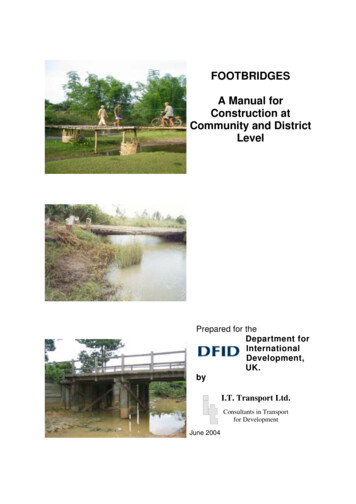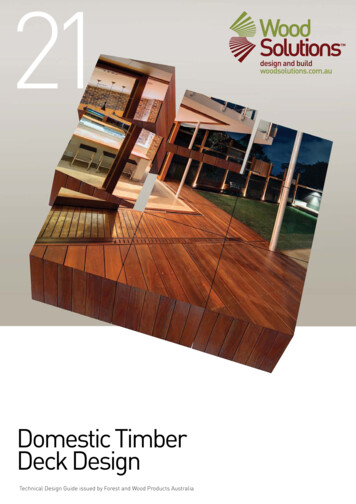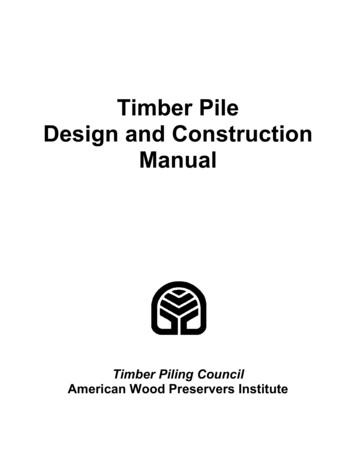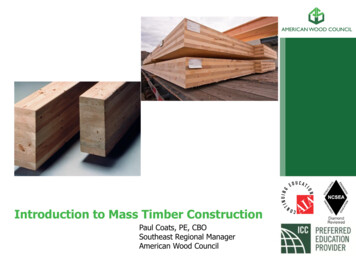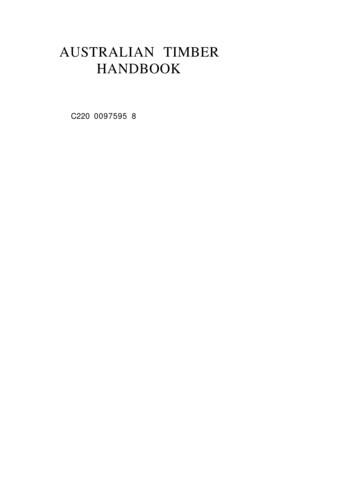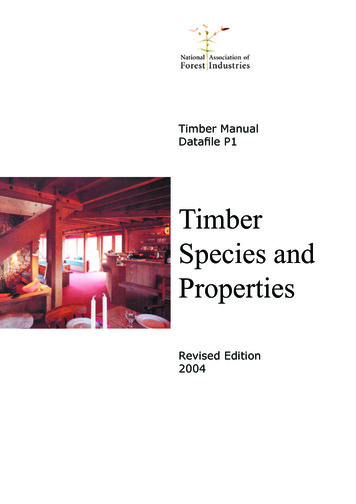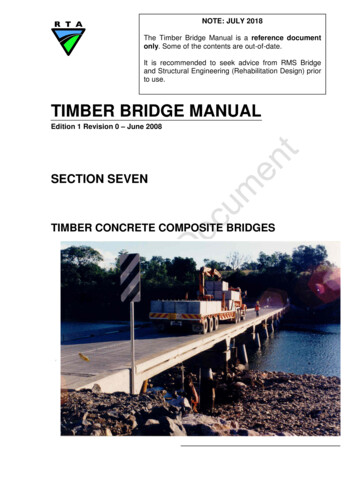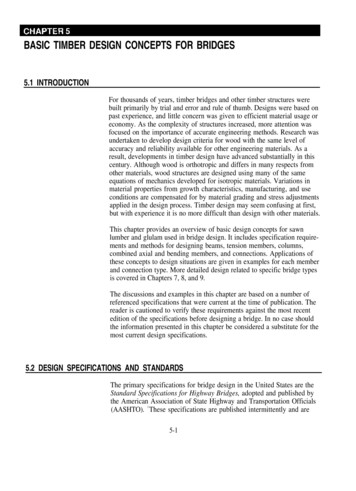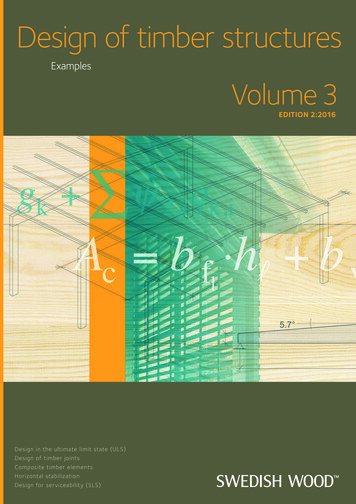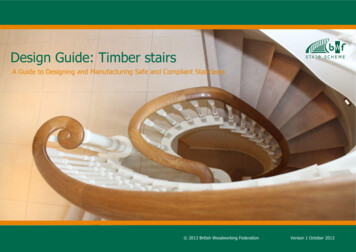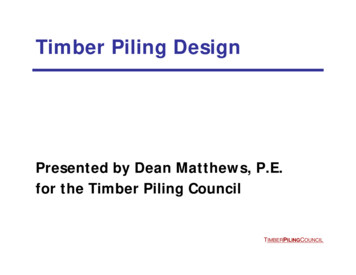
Transcription
Timber Piling DesignPresented by Dean Matthews, P.E.for the Timber Piling CouncilTIMBERPILINGCOUNCIL
Timber Piling Council The Timber Piling Councilprovides technicalinformation, and promotesthe use of timber piles in theconstruction industry. Photograph shows AmericanAirlines Terminal at JFK where11,000 timber piles wereinstalled.TIMBERPILINGCOUNCIL
Council Affiliations Deep Foundations InstitutePile Driving Contractors AssociationSouthern Forest Products AssociationSouthern Pressure TreatersAssociationAmerican Forest & Paper AssociationAmerican Society of Civil EngineersAmerican Society of Testing andMaterialsAmerican Wood ProtectionAssociationTreated Wood CouncilWestern Wood Preservers InstituteTIMBERPILINGCOUNCIL
History Placing a log vertically intosoft or unsuitable soil for astructural support is creditedto Neolithic tribes around6,000 years ago, in what isnow Switzerland. Homes were built onplatforms supported by pilesin lakes for protection fromwildlife. Evidence of these structuresstill exists today.TIMBERPILINGCOUNCIL
Roman Civilization Around 1620 B.C., the Romansbuilt a timber bridge spanningthe Tiber River which lastedover 1,000 years. Some roads and aqueductswere supported on timberpiles. They were still in goodcondition 1,900 years later.TIMBERPILINGCOUNCIL
Roman Civilization Buildings in the Roman citiesof Ravenna and Venice werebuilt on wood piles from 100B.C. to 400 A.D. The first bridge across theRiver Thames in London wasbuilt by the Romans about 60A.D. on timber piles.TIMBERPILINGCOUNCIL
Today’s Treating Plant The modern age of woodpreserving began in Englandin 1832. The first treating plant in theU.S. was built in 1848. Today’s plants have the latestin environmental protectionfeatures. Drip pads are protected fromleakage with heavy duty linersbelow the concrete, anddrippage is recaptured andrecycled.TIMBERPILINGCOUNCIL
Foundation Piling Timber piling resists attackfrom both alkaline and acidicsoil. Corrosion protection isnot required. Unaffected by electrolysisfrom stray electrical currents. Installs with standard, readilyavailable equipment. Takes advantage of plentiful,renewable resource. Has lowest cost per ton ofload carrying capacity of anydeep foundation material, andis easy to install.TIMBERPILINGCOUNCIL
Marine Piling Resists battering by wind,wave, storms and tides aswood is a resilient material. Excellent serviceability formarinas, dolphins andfenders. Wood’s high dampingcharacteristics provide built-inshock resistance againsthurricanes and earthquakes.TIMBERPILINGCOUNCIL
DurabilityThe Federal Highway Administration (FHWA) has concluded: Foundation piles submerged inground water will lastindefinitely. Fully embedded, treated,concrete capped foundationpiles partially above thegroundwater will last 100years or longer.TIMBERPILINGCOUNCIL
Long Lasting StructuresWell known structures ontimber piles include: San Francisco Ferry Terminal. London Bridge. Seine River bridges in Pariswere designed for 100 tonloads. Royal Palace in Amsterdam. Berlin Castle and Opera House.TIMBERPILINGCOUNCIL
Industry Statistics 90% of timber piles in NorthAmerica are Southern Pine,the balance is Douglas fir. Of Southern Pine piles, 95%are treated with CCA. Preservatives used for timberpiling are: CCA, creosote, andACZA (for Douglas fir). Copper Azole (CA-B) is nowavailable for piling. CA-B isAWPA approved for UseCategory 4C, which includesFresh Water Piling andFoundation Piling.TIMBERPILINGCOUNCIL
Resort & Marina Design Chesapeake Bay resort has140-slip marina with berths upto 65 ft. Marina – 2,000 timber piles,CCA treated 2.5 pcf. Approach bridges – timberpiles, heavy timber framing,CCA treated 0.60 pcf; roadwaysurface 3-inch decking. Golf course bridges – similarconstruction with piles,timbers and decking. Tee supported on timber piles.TIMBERPILINGCOUNCIL
Coastal Residential Design This house, built on piles inPearlington, MS, is reported tobe the only house thatsurvived flooding fromHurricane Katrina. Water came within severalinches of the pile girders, butnever entered the house. Similarly constructed beachhouses meeting coastal windload standards line the coastfrom New Jersey toMississippi.TIMBERPILINGCOUNCIL
Timber Pile FoundationsButt ω TipPiles are generally associated withdifficult foundation conditions andweak sub-surface soils.Piles transmit forces from the superstructure to a lower stratum that hassufficient bearing value to support thecompleted structures and all appliedloads.End-bearing piles primarily transferloads through the tip.Friction piles primarily transfer loadsthrough tangential skin friction.The natural taper of a timber piles (1”change in diameter per 10 ft.),increases the friction reaction and isrecognized in the design formula.TIMBERPILINGCOUNCIL
Design ValuesPiling design values for normal load duration and wet conditions ofuse. In pounds per square inch.1PropertySouthern Pine2Compression Parallel to Grain, Fc1,2002,400Extreme Fiber in Bending, FbHorizontal Shear, Fv110Compression Perpendicular to Grain, Fc 250Modulus of Elasticity, E1,500,000Douglas fir31,2502,4501152301,500,000Source: Values are from ANSI/AF&PA NDS-2005, National DesignSpecification for Wood Construction, Supplement for Timber Poles and Piles.1 A form factor for bending members of circular cross section is incorporatedin the allowable unit stresses for extreme fiber in bending listed in the table.2 Southern pine values apply to longleaf, slash, loblolly and shortleaf pine.3 Douglas fir values apply to Pacific Coast Douglas fir.TIMBERPILINGCOUNCIL
Original Stress Development Historically, stresses werebased on tests of small clearsamples, adjusted for woodcharacteristics such as knotsand knot clusters. ASTM Standard D2899provides the procedure fordeveloping working stressesfrom these tests. Allowable stresses wereoriginally developed by theU.S. Forest ProductsLaboratory.TIMBERPILINGCOUNCIL
Samples for Testing Samples for these tests wereselected in growing regionswhere piling is produced inproportion to the amountused for piling. Southern Pine piling wassampled from sites in Virginia,Georgia and Florida. Douglas fir piling was sampledfrom sites in Oregon,Washington and BritishColumbia.TIMBERPILINGCOUNCIL
Full-Scale Testing Tests on full scale pile pieceswere completed in 1999 and2000. The tests were specificallyconducted to develop designstresses. They were run byEDM International of Ft.Collins, CO, an independentlaboratory.TIMBERPILINGCOUNCIL
Bending Tests Bending tests were run first. A horizontal force was appliedby a cable attached to the tipof the pile. Tests showed bendingstresses could be 36% to53% higher than currentlyallowed for bending design.TIMBERPILINGCOUNCIL
Compression Tests Following the bending tests,3-foot specimens were cutfrom both the butt and tipends. Tests showed compressionstresses could be increasedup to 12% more than iscurrently allowed forcompressive design.TIMBERPILINGCOUNCIL
National Design Specification Timber Piling Council fullscale testing programdemonstrated that allowablestresses currently published inthe widely recognizedNational Design Specification(NDS) are conservative. The tests also demonstratedthat today’s trees are just asstrong as ever. The new ASTM standard,D7381, provides the protocolfor developing stresses fromfull scale tests.TIMBERPILINGCOUNCIL
Load Tests Many field load tests havebeen conducted on piles These many tests determinethat the actual load carryingcapacity of timber pilessignificantly exceeds designvalues with a wide margin ofsafety. Test procedure is ASTMD1143.TIMBERPILINGCOUNCIL
Test vs. Design LoadsSouthern Pine PilesPILE SIZEDESIGNLOADNO. OFLOADTips(tons)TESTS(tons)Class B140 & 1501609.5”14065Class A10050LOCATIONLengthDonaldsonville, LA80’ and upMobile, AL60’Virginia Beach, VA76’Charleston, SC75.8’14”8.25”118South Pierce, FL70’14”7”100Port Arthur, TX65’14”-15”8”-9”150575Chicago, IL43.7’-44.3’Class B80 & 150240Chicago, IL43.5’-48.2’Class A100 & 142240Portsmouth, VA86’Class A1001450Virginia Beach, VA40’1001150Scotland, LA53’10012401Not to failureSource: AWPI DataButtTEST14”15”8”15050TIMBERPILINGCOUNCIL
Timber Piling Manual Design Procedure. Foundation and Marine Piles. Timber Piling Data. Pile Group Design. Load Testing. Geo-technical Guidelines. Guide Specifications. Pile Installation.TIMBERPILINGCOUNCIL
Southern PineFoundation PilingSpecified Tip Circumferences with Corresponding Minimum ButtCircumferencesA,B (from ASTM D25 -- Table X1.5)(Approximate Diameters in Brackets)Required MinimumTip )38(12)In.Length (ft)Minimum Circumferences 3 ft from Butt, .0)47(15.0)55Commonly available sizes are .3)60within the bold outline: 49(15.6)65for ASTM Table X1.1 minimum 8 9)70tip size, sometimes known as 16.2)75taper piles, are shown in column )808 inch diameter tips. These are )85piles up to 45 ft. in 17.5)A To convert to metric dimensions, 1 in. 25.4mm.B Piles purchased as “8-in. and natural taper” have a required minimum tip circumference of 25 in. and are available in lengthsof 20 to 45 ft.C Southern Yellow Pine piles are generally available in lengths shorter than 70 ft. or girth of less than 50 in. at 3 ft. from butt.The purchaser should inquire as to availability of sizes below the lines.TIMBERPILINGCOUNCIL
Piling Standards ASTM D25 prescribeswhitewood requirementsbefore treatment, such asstraightness, knot size andknot clusters. AWPA standards prescribepenetration and retentionrequirements based on type ofpreservative and exposureconditions. Original AWPA Standards basedon performance of creosote.New preservatives have to beequal in performance.TIMBERPILINGCOUNCIL
AWPA Use Category System System simplifies use ofAWPA Standards. UC 1 Interior construction,dry. UC 2 Interior construction,damp. UC 3 Exterior construction,above ground. UC 4 Ground and fresh watercontact. UC 5 Salt water contact,marine construction.TIMBERPILINGCOUNCIL
Embankments Timber pile supportedembankment. Piles supported layers ofgeosynthetic material andcompacted soil. Piles installed on gridabout 9’ o.c. each way. More economical thanremoving soil andreplacing with compactedmaterial.TIMBERPILINGCOUNCIL
Quality Control Before treatment, piling isinspected and classified bysize and conformance to ASTMD 25 Standards. Quality control inspectors atthe plant monitor treatingprocesses, sample and inspectpiling throughout themanufacturing process. After treatment, the piling ischecked for penetration andretention according to AWPAStandards.TIMBERPILINGCOUNCIL
Preservative RetentionsCCA [pcf]ACZA [pcf]Creosote [pcf]Southern Pine Douglas fir Southern Pine Douglas firFoundationFresh WaterMarine: Saltwater1Marine: Saltwater2Dual Treatment31 020.017.017.016.020.020.0of the New Jersey/Delaware border in the East, and north of San Francisco in theWest.2 South of the New Jersey/Delaware border in the East, and south of San Francisco in theWest. Timber Piling Council members treat to this level, although AWPA Standardsrequire less treatment north of this border.3Treatment for tropical water—first treatment CCA, second treatment creosote.TIMBERPILINGCOUNCIL
Marine BorersTeredo and pholadareas.Teredo and limnoriatripunctata areas.Pholad and limnoriatripunctata areas.TeredoPholadLimnoria tripunctataTIMBERPILINGCOUNCIL
Termites & Carpenter Ants Wood in contact with theground will decay if notpreservative treated. Studies show the red,orange and blue regionsto be the most subject todeterioration. All piling must bepressure treated. The Formosan termite isnow in some places inthe South.TIMBERPILINGCOUNCIL
Environment Only EPA approvedpreservatives are used for anypressure treated woodapplication. It takes less energy toproduce timber piling thanother types of materials. Easy to dispose of cut-offs;they go to landfills. Treated wood is not ahazardous waste and meetsEPA’s TCLP (leaching)provisions.TIMBERPILINGCOUNCIL
Treated Wood inAquatic Environments Extensive empirical science andrisks assessments have shownthat in most applications,treated piling does not posesignificant adverseenvironmental risks. “Pressure treated wood has along history of safe use inaquatic environments with nopublished report describingsignificant loss of biologicalintegrity associated with itsproper use.” Source: TreatedWood in Aquatic Environments,WWPI, 2006.TIMBERPILINGCOUNCIL
Contaminated Sites orStagnant Water Where very large numbers of piles are proposed for use inhighly sensitive, poorly flushed and/or previouslycontaminated waters a risk assessment is advised to evaluateconformance with local regulatory limits for water andsediment quality. Guidance risk assessment can be accessed at Western WoodPreservers Institute’s web site: www.wwpinstitute.org.TIMBERPILINGCOUNCIL
Specifying BMPs Best available science showspressure treated wood posesminimal risk to aquaticenvironments when: Used in accordance with AWPAspecifications. Used following guidanceprovided by documents such asConsumer Information Sheets,Consumer Safety InformationSheets or treated wood MaterialSafety Data Sheets (MSDS). Produced using BMP’s.TIMBERPILINGCOUNCIL
New Preservatives Chemical producers voluntarily withdrew CCA from the consumermarketplace in 2003. CCA is still used for industrial purposes, including piling, bulkheads,utility poles and round fence posts. Non-arsenical treatments have been approved in AWPA Standardssince the late 1980’s. These include Copper Azole (CA) andAmmoniacal Copper Quat (ACQ), preservatives which provide thesame resistance to decay and insects as CCA. The new preservatives are more corrosive to fasteners so it isimperative to follow industry recommendations to use hot dippedgalvanized or stainless steel fasteners.TIMBERPILINGCOUNCIL
CCA Uses Permitted by EPA Timber Piles for Land, Foundation or Fresh Water uses: AWPA UseCategory 4C. Timber Piles and Timbers for Salt Water uses: AWPA Use Categories5A, 5B, and 5C. Timber Piles and Guard Rail Posts, etc. for Highway Construction:AWPA Use Category 4A. Dock Surfaces for Salt Water Construction: AWPA Use Category 5Aand 5B. Pole Frame Construction: AWPA Use Category 4B. Round Fence Posts: AWPA Use Category 4b. Permanent Wood Foundations. AWPA Use Category 4B.TIMBERPILINGCOUNCIL
Fresh & Saltwater UsesTimber Piles UC4C. Freshwater. 0.80 CCA, 0.80 ACQ, 12.0 Creosote. UC5A,B,C. Saltwater. 2.5 CCA, 20.0 Creosote or Dual Treatment.Structural Lumber UC4A. Freshwater. 0.21 CA, 0.40 ACQ, 10.0 Creosote. UC4B. Saltwater Splash Zone. 0.60 CCA, 0.31 CA, 0.60 ACQ, 12.0Creosote. UC5A,B,C. Saltwater Immersion. 2.5 CCA, 20.0 Creosote (Crossbracing).Decking, Handrails UC3B Freshwater. 0.10 CA, 0.25 ACQ. UC3B. Saltwater. 0.10 CA, 0.25 ACQ. Effective January 1, 2005 for decking and handrails.Refer to page 10 of Marine Structures Brochure.TIMBERPILINGCOUNCIL
Southern Pine Resource Grown on managed timberlands throughout the South.A renewable natural resource;fourth generation forests ormore are now growingSouthern Pine trees.The U.S. has about the sameamount of forest area todayas 100 years ago.Forests have expanded nearly10 million acres in the lastdecade. Source: UnitedNations satellite tracking.No old growth trees are usedto produce timber piling.TIMBERPILINGCOUNCIL
Managed Forest The stands in the backgroundwere selected to provide 70 ft.and 75 ft. long timber piles. The small trees in theforeground are three years oldand will be timber piles inabout 40 years. This stand was thinned afterabout 20 years of growth. Today, trees are harvestedfrom forests that werenaturally seeded.TIMBERPILINGCOUNCIL
Pile Installation Pile driving process is a test ofthe piling material. Whetherwood, steel or concrete, thematerial is severely stressedduring driving. With driven piles you caninspect the material beforedriving. Hammer manufacturers havevery sophisticated equipmentincluding, hammers that drive300 ft. long piles, andhammers that drive pilesunder water.TIMBERPILINGCOUNCIL
Field Cuts and Re-treatment Cut surfaces must be fieldtreated in accordance withAWPA Standard M-4. 2% copper naphthenate isrecommended. Same as requirement forpressure treated sill plateswhen they bear on concreteslabs or walls.TIMBERPILINGCOUNCIL
Summary The unsurpassed timber pile!Proven by time and tests.The recognized economical piling.Environmentally sound and safe.Timber Piling @timberpilingcouncil.orgTIMBERPILINGCOUNCIL
Resort & Marina Design Chesapeake Bay resort has 140-slip marina with berths up to 65 ft. Marina – 2,000 timber piles, CCA treated 2.5 pcf. Approach bridges – timber piles, heavy timber framing, CCA treated 0.60 pcf; roadway surface 3-inch decking. Golf course bridges
